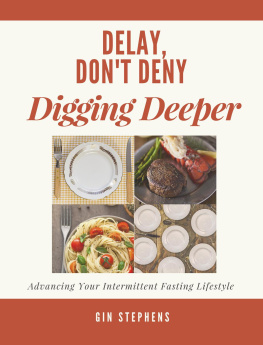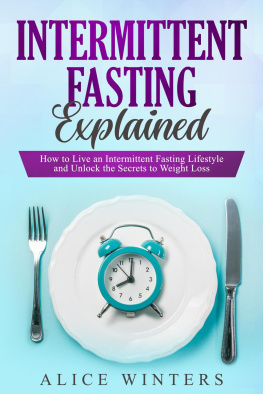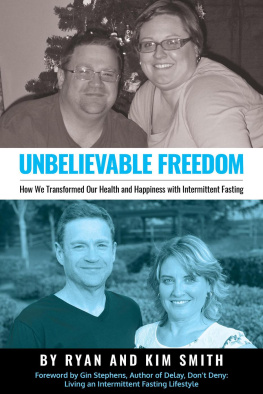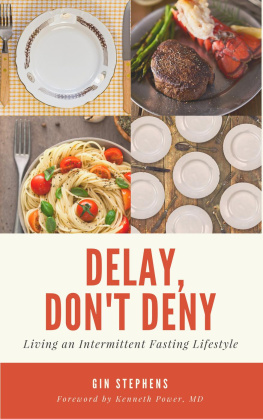Delay, Dont Deny
Digging Deeper
Advancing Your
Intermittent Fasting Lifestyle
Gin Stephens
Also by Gin Stephens:
Delay, Dont Deny:
Living an Intermittent Fasting Lifestyle
Feast Without Fear:
Food and the Delay, Dont Deny Lifestyle
Delay, Dont Deny LIFE Journal:
Charting Your Intermittent Fasting Lifestyle
Available through most online book and e-book retailers.
Visit
www.ginstephens.com
for blog posts and intermittent fasting success stories
Subscribe to The Intermittent Fasting Podcast !
Go to
www.ifpodcast.com
to learn more
Copyright 2018 Gin Stephens
All rights reserved.
ISBN: 1722831596
ISBN-13: 978-1722831592
Disclaimer
This book is not a substitute for medical advice. All information presented within this text is intended for motivational purposes. Any health, diet, or exercise advice shared here is the opinion of the author, and is not intended as medical diagnosis or treatment. If you think you have any type of medical condition, you must seek professional advice, even if you believe it may be due to diet, food, or exercise. You should always consult a qualified practitioner before using any dietary, exercise, or health advice from this text.
Introduction, and how to use this e-book
W hether you are new to the Delay, Dont Deny (DDD) lifestyle or an experienced intermittent faster, you are here because you are looking for a tool that will allow you to dig deeper into the book Delay, Dont Deny: Living an Intermittent Fasting Lifestyle . This e-book is designed to be used as a companion to Delay, Dont Deny, so it wont replace reading the original book. You will use this e-book alongside the original book to explore the concepts and practices in greater depth and to reflect upon their application within your life.
This e-book is organized into the same chapters as Delay, Dont Deny , and it has chapter-specific questions for you to reflect upon. You may choose to complete each section sequentially or to skip around as you feel the need. Throughout this e-book, I will talk directly to you, just as I did in the original book. (And, if you are a podcast listener, you can probably imagine my voice in your head as you read!) Ill give you a homework assignment for each chapter that will require you to read (or re-read) the corresponding pages from DDD (hey, Im a teacher, after all). For some of the chapters, I am also going to share additional study resources that go along with the concepts. These additional resources will allow you to truly dig deeper into the ideas and concepts found within DDD.
This e-book is designed to be used either individually or within a support group. If you are using this e-book as part of a support group, I recommend that you focus on one chapter at a time within your group. Before your group meeting, agree on your focus for the upcoming session. Each member should do the reading and answer the questions alone prior to the meeting. Then, discuss the concepts together at the meeting. Youll use the questions you answered ahead of time to stimulate your group discussion and once again deepen your understanding. For the chapters that have more in-depth content to explore, you may even want to break up the discussion into more than one session, so you have sufficient time to delve into the complexities within that chapter.
Now! Lets get started, shall we?
To work through this e-book, you will need two things: a copy of Delay, Dont Deny and a notebook, binder, journal, or notepad, plus something to write with. For each chapter, youll start by reading the original chapter from Delay, Dont Deny . Using your notebook, take notes, record your thoughts, or add any reflections you have while reading. Next, dig into any additional resources provided (for the chapters with a Dig deeper section). Then, answer the questions that go along with each chapter. Finally, youll finish up each chapter with a Food for Thought section, where you can wrap up what you have learned.
Chapter 1: All of the diets work and none of them work
H omework assignment :
- Read Chapter 1 of Delay, Dont Deny (pages 11-14 of the paperback edition).
- While reading...Record notes, thoughts, and reflections in your notebook.
- Now, reflect upon your own diet history by answering these questions in your notebook.
1. What are some of the most extreme or craziest diets you ever tried?
2. Are there any diets that did seem to work for you, at least in the short term? Make a chart with 4 columns. Give each column a heading: Diet, Positives, Negatives, & Why it Didnt Work for me Long Term. List the diets you tried in the Diet column, and for each, explain what you liked about each one (Positives), and what was difficult about each (Negatives). Also consider why each didnt work for you long term.
3. Now that you are living (or considering) an intermittent fasting lifestyle, what are you most excited about? Are there any challenges that you anticipate? How do you think intermittent fasting will change your life?
Chapter 1: Food for Thought
1. What are the most important take-aways from digging deeper into this chapter?
2. Did digging deeper into this chapter uncover any challenges you need to face?
3. Is there anything you want to tweak after digging deeper into this chapter?
Chapter 2: The obesity epidemicwhy are we so fat?
H omework assignment :
- Read Chapter 2 of Delay, Dont Deny (pages 15-18 of the paperback edition).
Dig deeper:
- Go to the Center for Disease Control website at:
https://www.cdc.gov/obesity/data/databases.html
and take a look at the some of the maps, trends, and statistics. As an example, I went to the Adult Obesity Prevalence Maps and was able to see that the rate of obesity is greater than 20% for all fifty states in America, with some states topping 35%. (These numbers are from 2016, which was the most recent data available when I viewed the website.) The Data, Trends, and Maps section allowed me to dig in to the data from my state, which was shocking. In 2016, over 31% of adults in my home state of Georgia were obese (BMI of 30 or higher), and over 34% were overweight (BMI between 25 and 30). When you put the two together, that adds up to over 65% of the population of my state. Our neighbors to the west in Alabama have even higher numbers: in 2016, almost 36% were obese, and almost 34% were overweight, which adds up to almost 70% of the state. Clearly, something is not working well for us.
Next page













